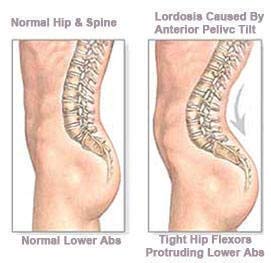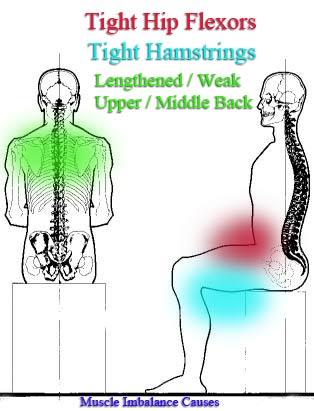- Like
- SHARE
- Digg
- Del
- Tumblr
- VKontakte
- Flattr
- Buffer
- Love This
- Save
- Odnoklassniki
- Meneame
- Blogger
- Amazon
- Yahoo Mail
- Gmail
- AOL
- Newsvine
- HackerNews
- Evernote
- MySpace
- Mail.ru
- Viadeo
- Line
- Comments
- Yummly
- SMS
- Viber
- Telegram
- JOIN
- Skype
- Facebook Messenger
- Kakao
- LiveJournal
- Yammer
- Edgar
- Fintel
- Mix
- Instapaper
- Copy Link

Do you struggle with lower back pain? Do you feel like it hinders your ability to make progress in the gym?
It can be hard to figure out the root cause of lower back pain. But, one of the most common causes is a condition known as anterior pelvic tilt. This condition affects as much as 85 percent of men and 75 percent of women.
Read on to learn more about anterior pelvic tilt and what you can do to start correcting it.
What is Anterior Pelvic Tilt?
Anterior pelvic tilt is a type of postural deviation that occurs when your pelvis tips forward. It is also known as lower crossed syndrome.
People who have anterior pelvic tilt tend to have a prominent arch in their lower back, with their abdomen sticking out and hips pushed back.
How to Tell if You Have Anterior Pelvic Tilt
Sometimes, it’s easy to tell if you have anterior pelvic tilt just by turning to the side and looking in the mirror. If you’re not sure, though, evaluate yourself for these other common symptoms:
- Lower back pain
- Tightness in the lower back
- Knee hyperextension
- Tight hamstrings
What Causes Anterior Pelvic Tilt?
 Some people are genetically predisposed to have anterior pelvic tilt. However, the condition can also be brought on by the following factors:
Some people are genetically predisposed to have anterior pelvic tilt. However, the condition can also be brought on by the following factors:
- Excessive sitting (especially sitting with poor posture)
- Sedentary lifestyle
- Poor exercise technique (especially arching your lower back excessively while squatting or deadlifting)
- Muscle imbalances
- Imbalanced training (specifically neglecting the abdominal and glute muscles)
- Foot pronation while walking or running
How to Correct Anterior Pelvic Tilt
![]() Anterior pelvic tilt isn’t exactly easy to correct. After all, it takes a while to relearn the way you carry yourself. But, the exercises you can implement to improve your posture are fairly simple.
Anterior pelvic tilt isn’t exactly easy to correct. After all, it takes a while to relearn the way you carry yourself. But, the exercises you can implement to improve your posture are fairly simple.
Add the following exercises to your routine to improve your posture and reduce anterior pelvic tilt.
1. Practice the Lying Pelvic Tilt
This is one of the most important exercises you can do to strengthen weak muscles and correct your form.
Start by lying flat on your back with your knees bent. Then, pull your abdominal muscles in, tuck your tailbone, and press your lower back into the ground. This will help you understand how it feels to engage your abdominal muscles and prevent your pelvis from flaring out.
2. Practice the Standing Pelvic Tilt
Once you’ve mastered the lying pelvic tilt, it’s time to move on to the standing pelvic tilt.
This exercise is all about squeezing your glutes and pulling your abdominal muscles in toward your spine. When you do this, your pelvis will naturally move to a neutral position.
If you’re having trouble figuring this out, try wearing a posture corrector for a little while. This will help you get used to proper posture so you know which muscles to engage.
3. Learn to Hip Hinge
Learning to hip hinge when doing exercises like deadlifts will help you avoid over-arching your back. One of the best exercises for this is a cable pull-through.
Stand with your back facing a cable machine with a rope attachment. Then, hinge at your hips and reach through your legs to grab the attachment and pull it through as you return to a standing position.
Focus on pushing your hips back during the hip hinge while keeping your back straight and chest lifted. Squeeze your glutes at the top of the exercise.
4. Stretch Your Hip Flexors
Finally, make sure you’re taking time to stretch your hip flexors. When your hip flexors are overactive, you’re more likely to experience a greater degree of anterior pelvic tilt.
A lunge is one of the best stretches you can do to loosen up tight, overactive hip flexors.
Start with both knees bent at ninety degrees, one in front and one in back. Pull your abdominal muscles in and think about tilting your pelvis back (like you did in the lying and standing pelvic tilts).
It can be tempting to arch your back during this exercise, but tilting your pelvis back will help you get a deeper stretch and keep your hips properly aligned.
